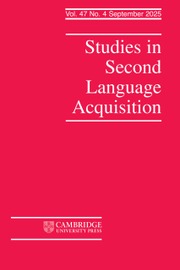Article contents
SECOND LANGUAGE ATTRITION IN JAPANESE CONTEXTS. LynnHansen (Ed.). Oxford: Oxford University Press, 1999. Pp. xi + 219. $35.00 cloth.
Published online by Cambridge University Press: 25 September 2001
Abstract
Researchers interested in second language attrition have studied a wide variety of bilingualspeakers, ranging from foreign language students who learned a language through classroomstudy to those who have developed high proficiency during life abroad. What these studies have incommon is their investigation of questions related to bilingual speakers' loss of L2knowledge or proficiency. Hansen's collection of papers presents research on a range ofbilingual speakers who have the Japanese language in common, whether that language is their L1or L2. The book is divided into two major sections. The first section, consisting of three papers,presents studies of Japanese children of elementary school age who learned English while livingabroad but who have returned to Japan. This section will be of interest to EFL teachers ofchildren as well as to L2 researchers. The four papers in the second section of the book examinethe attrition of Japanese by adults. Most of these adults became subjects while residing in theUnited States after working or studying in Japan. The adults studied in these chapters had avariety of different combinations of exposure and formal study and also a broad range of yearsaway from Japan, from 9 months to 30+ years. Additionally, the subjects of one study never livedin Japan at all but learned Japanese during Japan's occupation of Micronesia.
Information
- Type
- Book Review
- Information
- Copyright
- 2001 Cambridge University Press
- 2
- Cited by

